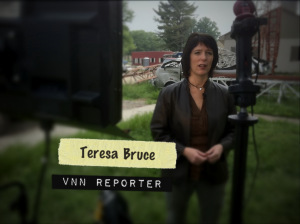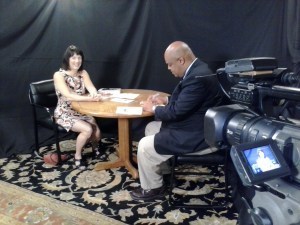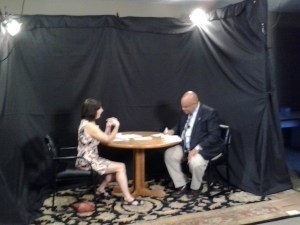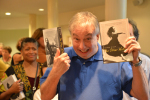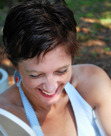Teresa Bruce's Blog, page 37
October 22, 2013
A Soiree for Other Mothers Everywhere
“Somewhere in the years of knowing Byrne, she had become my other mother, fearless and larger than life. I couldn’t have explained to the doctor or anyone when or how it happened any more than I could pinpoint the first time I became aware of my own name.” — Chapter 42 “The Other Mother: a rememoir”
I may never remember the exact moment I found an Other Mother in Byrne Miller, but I will always remember the moment I realized that all women, instinctively, get it. It happened last night, at the first ever “Other Mother Soirée.”
My friend and fellow writer Barbara Kelly had the idea to combine a celebration of my memoir about Byrne and a tribute to the other mothers in all our lives.
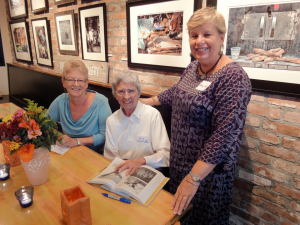
Barbara’s Other Mother: Betty Tenare
Her soirée invite list started with her own Other Mother – Betty Tenare. In the same way Byrne added me to her collection of daughters, Betty befriended Barbara when she first arrived in Beaufort and folded the nervous newcomer into a circle of support.
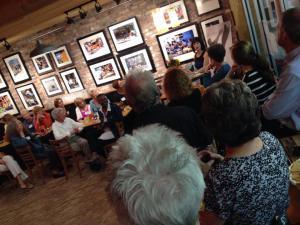
Inaugural Other Mother Soiree in Beaufort
Betty sat just to my right as I read this passage from “The Other Mother: a rememoir” and I could literally feel how proud she is of Barbara and of being an Other Mother. Just as Byrne was.
“I didn’t have to ask what Lillian meant by collected daughters. I was beginning to know the silky feel of Byrne’s favor, the web she wove that made me feel more charming, witty and talented than I did with anyone else.”
—Chapter 14 “The Other Mother: a rememoir”
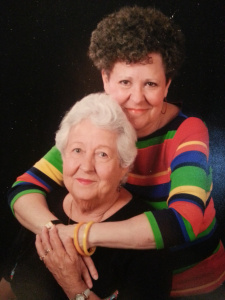
The mother Casey shared with others
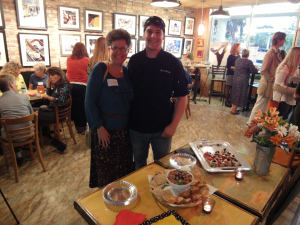
Casey Chucta and chef Jamie Darby of Beaufort Bread Company
When we weren’t feasting on chef Jamie Darby’s creations, we raised glasses of wine and shared toasts and stories of Other Mothers. Some were literally shared. Like Casey Chucta’s story of how she used to be jealous of all the people “adopted” by her charismatic, theatrical parents Bob and Roxie. But then, when so many people paid tribute to her father at his funeral, she realized how lucky she was to have inherited an extended family. All because her father was an Other Father and her mother a generous, loving Other Mother.
[image error]
Members of the first book club reading “The Other Mother: a rememoir”
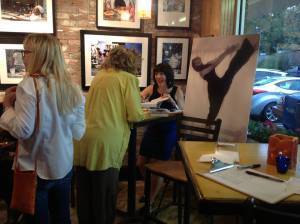
Me, meeting another woman who cherishes Other Mothers
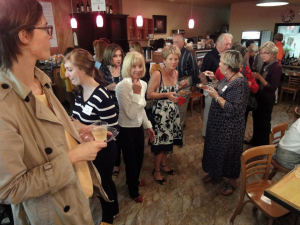
Josefina Blanc, on the left, and one of her Other Mothers: Barbara Kelly
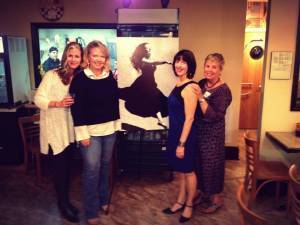
More women who write — Margaret Evans, Ann Marie Adams to the left of me and Barbara
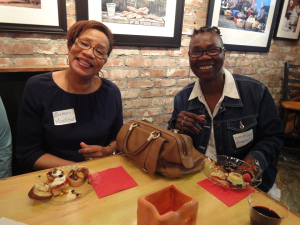
Veronica Lynch and Susan Madison — who found her Other Mother in a German woman on St. Helena Island!
As a writer, it doesn’t get better than witnessing the way a book can connect people. Last night was my first chance since the Beaufort launch to sit back and revel in the power of othermothering. But there will be more opportunities. Two other dear friends, Andrea in Charleston and Audrey in Washington, D.C., are hosting Other Mother Soirées for me at their homes in November. And my TEDx talk in Charleston, on lessons from my Other Mother, keeps getting more views and likes as the national book release gets closer. Who knows, I may be collecting a few daughters of my own as this dance continues.


October 15, 2013
I’m out of the closet — confessions on recording an audio book
Let me apologize right up front if you were stuck behind my little white Mazda on I-95 in the late ’90s, headed south from Washington D.C. to Beaufort, South Carolina. You probably passed me in a furious hurry and wagged your finger at the sight of a furry white dog licking the tears streaming down my face as I drove. You are forgiven for whatever blond, female driver accusation you probably hurtled at me. I blame it all on audio books. One in particular: Mitch Albom’s “Tuesdays with Morrie.” Not only did this book-on-cassette keep me awake, though admittedly distracted, on the nine-hour drive to visit Byrne Miller, it changed the way I understood aging, love, grief and honesty.
Fast forward a few cars, years and hair colors later, and you’ll understand why I knew I wanted to record an audio book version of “The Other Mother: a rememoir” as soon as it was published. As a kid, I adored hearing my mother read books to me and I never outgrew it. I had to get over the weirdness of hearing my own voice when I decided to become a television reporter and studied delivery techniques with a vocal coach in grad school. I’ve been lucky enough to voice everything from documentaries for ETV to virtual news networks for the Department of Homeland Security and a Short Story America piece which aired on NPR.
So when Joggling Board Press’s marketing and social media guru, Will Green, said his recording studio at the JBP offices in Summerville was ready for me I had no reservations. He figured we’d get halfway through if we recorded “The Other Mother” for three days straight. I packed an overnight bag but thought we’d get through much more than that. Afterall, I was known as “one-take Teresa” back at WJWJ.
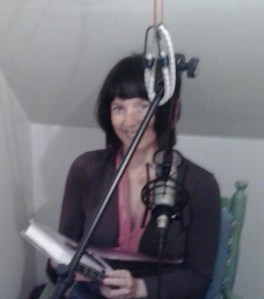
Perky. Caffeinated. Ready to go.
This is me, on day one of the audio book recording. In a closet. Literally. It’s so small the mic stand legs can’t spread far enough to balance without bungee cord assists. If I felt compelled to do a chicken dance my elbows would scrape the walls.
Now I can’t actually say that I’ve never voiced in a closet before. Back in my Ogilvy days, I had to cut the voice track of a video news release in a storage closet of a conference room at the World Trade Center. But that script was one page, about a minute’s worth of copy. “The Other Mother: a rememoir” is 417 pages – with no soundbites to break up the narration.
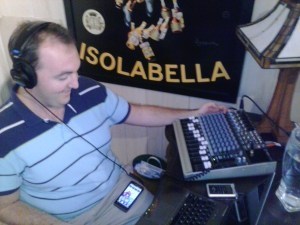
Will Green, Day One
Will designed his studio so that he gets to sit outside the closet, listening to the recording through comfy hipster headphones at a spacious desk. The “talent” has to pass strict height and girth requirements to even fit in the shoe-box sized recording booth. Even so, the first day was fun. I tried to image that I was curled up in bed, reading the love story of Byrne and Duncan Miller for the first time. Hours sped by and despite the fact that a guy Will’s age is definitely not the target audience, he fell under the spell of the book as well.
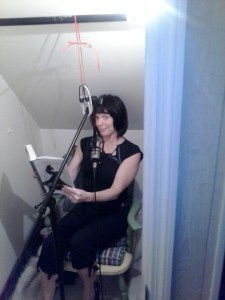
Day Two. Cramped, but hanging in there.
Day two I was a little stiff and sore but my voice was holding up. Susan, my editor and the publisher of Joggling Board Press, had plenty of hot tea and honey on hand and made me stop for soothing snack breaks of plump and juicy grapes (She’s clearly got a bit of Other Mother in her.)
Even when you’ve written and rewritten, and edited and re-edited the words in front of your face, there are surprises in a marathon recording session. Like the sheer number of French and Spanish words that somehow ended up in the book. I don’t speak French, unless you count the ballet terms I learned as a kid. I had to rely on my memory of the way those dance terms sounded on the lips of many dance teachers. The street Spanish sprinkled through the pages are much fresher memories and I’ve always found the language lyrical and lovely to speak.
The tough part came when I hit the chapters where I incorporate lyrics from The Doors into the dialog between young Teresa and her common-law-husband. It made perfect sense when I wrote the book. The half-Mexican surfer character, Sonny, listened to Jim Morrison all the time. Songs like “Gloria,” “Light My Fire” and “The End” and were the soundtrack of our relationship.
But when they popped back up in front of me, I had to make a split second decision about how to deliver those lines in spoken form. On the first pass I did it straight.
Now that we know each other a little bit better, why don’t you come over here? Make me feel alright.
I could hear Susan’s guffaw from the other side of the closet wall. My PBS-serious delivery of a familiar lyric was laugh-out-loud funny. We took a break. Listened to the song on the internet. Marveled at the way Jim Morrison manages to sound simultaneously stoned and psychic. He sneers the words and yet they’re seductive. He belts out “make me feel alright” with a raspy earnestness that still makes fathers guard their daughters with shotguns.
I tried imitating it. It was even funnier than saying it straight. I tried sing speaking it. I sounded more ridiculous each minute. Finally we decided I would try to deliver the line with Jim Morrison’s cadence and rhythm since there was no way I could mimic anything else. I climbed back into the closet, took a deep breath and only exhaled when I didn’t hear Susan or Will laughing. We did multiple takes and I’ll leave it to the judgment of a 29-year-old man to pick the version least likely to elicit howls from future listeners.
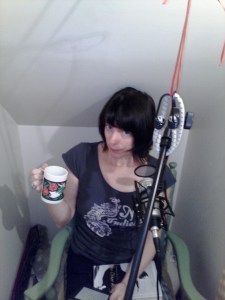
Day Three. Raspy. Hair that wants to go home.
Day three and I was so claustrophobic, in character and eye-strained that I would have belted out any Jim Morrison lyrics with abandon. My one-take reputation began to crumble. Infusions of Starbucks didn’t even help. As I read each chapter I kept thinking of my likely audience – women of all ages – and how they wouldn’t be charmed by the froggy, come hither instrument my voice was becoming. We took a long lunch break and I let Will and Susan do all the talking, thinking I’d bounce back. Still, by two o’clock I was clearing my throat with more frequency than I finished sentences. I learned exactly where vocal chords begin, lower down than I had assumed before they started stinging and chafing like sand paper on a paper cut.
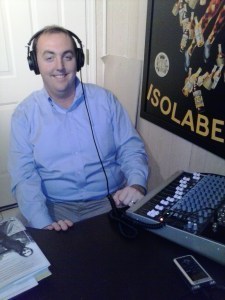
Will Green, Day Three.
Ironically, just as I was falling apart, Will was hitting the book’s stride. It’s riveting stuff – electroshock therapy, schizophrenia, burlesque, open marriages, and phony marriages. He was following along so closely that he could almost predict when I would switch words or omit them altogether. At 2:30pm, a shade before the Kindle counter said I’d reached 50% of the book, Will made the executive decision to stop and record the rest when my voice has recovered.
The Other Mother: a rememoir” may be deliciously intriguing, even shocking, but it shouldn’t sound like I’m reading “Fifty Shades of Grey.”


October 8, 2013
On the wrong side of the camera
Don’t be nervous. This’ll be fun. Your hair looks fine. No, the questions aren’t hard. Sure, that outfit works on camera.
I’m not proud to admit I served up these platitudes to countless interviewees back when I was a reporter and anchor at the PBS affiliate in Beaufort, SC: WJWJ-TV. And when I left the newsroom to make public relations films in Washington DC, I re-warmed those same tired sayings to ease the anxiety of corporate CEOs and newly minted spokespeople.
Today was payback. I found out what it’s like to be on the wrong side of the camera because my former co-anchor and friend Juan Singleton interviewed me for the TV program he now hosts for the City of Hardeeville.
I knew this day would come. I’m grateful for the chance to introduce new audiences to “The Other Mother: a Rememoir” because I believe in the book and want it to be a best-seller for Joggling Board Press. I’m eternally grateful that my first TV interviewer was Juan, instead of a recent J-school graduate who will probably never read the book or care about an octogenarian dancer who started out doing burlesque in the Great Depression. But it was still waaaay harder than I thought it would be.
First of all — where is it written that I look nothing like I did back in my anchor days and yet Juan Singleton hasn’t aged a day?
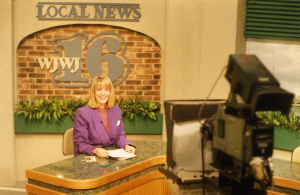
Yes, that’s actually me
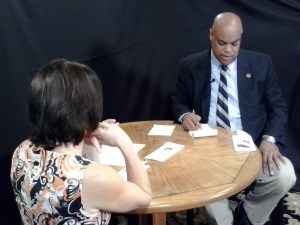
Juan Singleton, formerly also of WJWJ
Now it’s not like I’ve completely forsaken my TV identity. It was really helpful in my Ogilvy days — I actually enjoy “media training” clients. And when I’m not writing books and screenplays, I still use my reporting skills for simulated news programs for clients like the Department of Homeland Security.
Those gigs are for “field reporting” — and nowadays reporters can even get away with wearing leather jackets. But for Juan’s interview segment, I had to be an author. And I realized as soon as I got on set this morning that there was a good reason I always told guests not to wear black. It disappears on camera, especially when the backdrop is Charlie Rose serious. Suddenly forced to go sleeveless, the only thing more mortifying was realizing that my dress showed just as much bare leg as bare arm on the two-shot. I’d fire me, if I gave anyone that kind of wardrobe advice.
Once the cameras started rolling, I tried to forget about my various wardrobe malfunctions and concentrate on my message. I’m one of a long list of writers reading excerpts from their books at the inaugural literary festival called a “Novel” Wine tasting” at September Oaks Vineyards in Ridgeland, SC on October 26th.
Phew, I managed to get that out in one sentence. Although my husband Gary, who was sneaking pictures during my interview on my cell phone, says I talked about twice as fast as my genteel, Southern born-and-bred host.
It was Juan’s open-ended questions that presented a bigger challenge. I was a master at those too, back in the WJWJ day. We all were. I think Suzanne Larson set the world record for asking one, strategically open-ended question and letting the interviewee answer for something like 17 minutes straight. We all loved it when a Byrne Miller Dance Theatre concert was coming up. You just had to introduce Byrne and she’d seduce the cameras, and our audience.
But I knew Juan’s entire segment was supposed to be about 7 minutes. Suddenly this process I’ve always brushed off as easy, wasn’t! How was I supposed to describe what an Other Mother is, how I met Byrne Miller, what she meant to me, why I wanted to write the book — in just 7 minutes? The same queasy nerves that attacked right before my TEDx talk in Charleston threatened to make an appearance, until I remembered one my favorite Byrne Miller womenisms.
“Innate intelligence is surpassed by impeccable instincts.” — Chapter 4, The Other Mother: a Rememoir
It was TV, not brain surgery. I wasn’t being summoned to testify in front of a senate subcommittee. Juan Singleton was not the late Mike Wallace, going for the jugular. He just wanted to know more about a woman I loved enough to write a book about. (It turns out Byrne taught him a dance class or two back in her days at Beaufort Elementary.) I took a deep breath. Nobody would know if I messed up a detail from the book; that’s the beauty of becoming the expert in all things Byrne Miller. I could rely on my old TV instincts and just tell the story.
Which is when another of Byrne’s womenisms popped into my head.
“There is not a contract on earth that can’t be rewritten.” — Chapter 33, The Other Mother: a Rememoir
So what if Juan’s interview segments are normally seven minutes? It’s not set in stone. I just had to make him forget the stopwatch. It’s easy, when I’m talking about Byrne Miller. Hardeeville residents can watch the program on TV. The rest of us will get to watch it online — sometime next week — on the city’s website. As I used to say every night at 6:30 pm, “This is Teresa Bruce, reporting.”


October 3, 2013
How a mermaid gets in hot water
As readers of my new book “The Other Mother: a Rememoir” now know – my mermaidenhood is fishy, to say the least. I come clean in the book, as all memoirists should. There’s a whole chapter disclosing how my scaly side came about and I wouldn’t dream of spoiling the book for you by giving away any important details.
Instead, this is a blog about consequences. My publisher, Susan Kammeraad-Campbell, is a big believer in mermaids herself so she saw no harm in putting proof on the invite that we mailed out to supporters and friends of Byrne Miller – my other mother. I figured it’d come out soon enough anyway, since its one of the photos actually in the book.
[image error]
“The Other Mother: a Rememoir” launch invite
What I didn’t count on is the whirlpool of confusion it would create for two of my favorite little girls in the known universe. Ann is a 10-year-old who lives in Beaufort (top photo) and Marina is my niece, ( bottom photo) an almost 9-year-old who lives in Florida. Both girls saw the invite with my mermaid picture. Both girls were shocked – for different reasons.
For Anne, it was more about the picture. She’s never known me before I dyed my hair black, so there’s that issue. (It seems a lot of people have that issue. I’m so not a blonde anymore. Just accept it.) She’s also never seen my mermaid tail. And that’s a problem, since we are swimming buddies who spend hours each summer cavorting in the creek behind my house. I’ve always told her I was a mermaid, but she wrote it off as just another inane thing her silly friend says to make her laugh. I’m not sure how it’s going to play out. Anne came to the launch but was suddenly shy, as if she wasn’t sure who the heck I really was anymore.
Marina had seen the picture before. She was scared that by putting it on the invitation everyone would find out and it wouldn’t be a family secret anymore. We have lots of secrets in my family – this is probably the only good one. My mermaidenhood is something like an exclusive club – even her older brothers are sworn to secrecy. Her concern is entirely logical, given that the reason I’ve always given her for my tail not showing itself anymore is that I’ve been suspended by mermaid management. On account of the first time my nephews saw my tail, in the bathtub, conveniently captured in the photograph. It happened before Marina was born but such is the way of legends.
[image error]
September 25, 2013
Celebrating The Other Mother
A sixteen-year-old girl from Beaufort High School bought a copy of “The Other Mother: a rememoir” on the night of it’s launch. Here’s why that makes my heart do a grand jete. It isn’t a YA book about young love, vampires or zombies. It isn’t about a celebrity or anyone her friends tweet about. It will never be made into an app or video game. So why did she part with hard-earned babysitting money to buy a 417-page book about my relationship with a former burlesque dancer named Byrne Miller?
“I danced for Ms. Miller in the Nutcracker when I was four,” she told me. “And I never knew she was so amazing until tonight.”

Me, on the very stage Byrne knew so very well

 Almost five years of research, writing, rewriting and planning this book’s introduction to the world was worth it in that instant. Byrne was Other Mother to me and many other former dancers in the audience of the USCB Center for the Arts. We were all drawn to her exuberant positivity and consider ourselves lucky to be her collected children. One of the best parts of writing “The Other Mother” was the reuniting with many of them, telling and retelling the stories Byrne planted in each of our hearts.
Almost five years of research, writing, rewriting and planning this book’s introduction to the world was worth it in that instant. Byrne was Other Mother to me and many other former dancers in the audience of the USCB Center for the Arts. We were all drawn to her exuberant positivity and consider ourselves lucky to be her collected children. One of the best parts of writing “The Other Mother” was the reuniting with many of them, telling and retelling the stories Byrne planted in each of our hearts.
But I wrote the book so that the next generation of young women would have the chance to know Byrne Miller too. I told the unbelievably big crowd of book and Byrne lovers that all young women deserve the wit and wisdom of an Other Mother.

I’m a first-timer. I have no other book launches or signings to compare to Byrne’s kickoff celebration. All I knew was that I wanted it to be an event worthy of the woman with a whim of iron who introduced modern dance to the Deep South. I also wanted it to be an homage to my adopted hometown – the place Byrne and Duncan Miller chose, as I did, to live and create. Beaufort is more than a setting in this work. It is a central character.
After sharing some crowd-pleasing passages from “The Other Mother,” I watched from the back of the auditorium as two groups of dancers performed modern and contemporary pieces choreographed in Byrne’s honor. I confess when the idea for making the launch more than a typical book signing first occurred to me, I was worried that the dancers I’d invited would wear the kinds of costumes you see at recitals or that their moves would mirror what you see on music videos. Byrne was an unrepentant dance snob and even twelve years after her death I’m certain she could still summon lightning bolts of judgment.
But the moment the music started I felt my muscles lengthen, my posture correct itself and tears roll down my cheeks. These Beaufort Middle School and High School dancers are the living, breathing legacy of what Byrne Miller started decades ago. On the night of the worldwide debut of a book in her honor, they were lyrical, expressive and as committed as any modern dance company the Byrne Miller Dance Theatre ever brought to Beaufort. And if even one of them loves reading “The Other Mother: a Rememoir” I will be as proud as Byrne surely is.


September 17, 2013
Hello Baby! Welcoming a book into the world
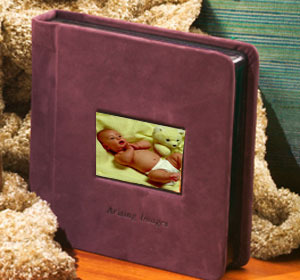
Hmmm… great idea
Regular moms make cute little photo albums when their babies arrive. I’m about to bring a new book into the world — “The Other Mother: a rememoir” so why not create an album for my baby too?
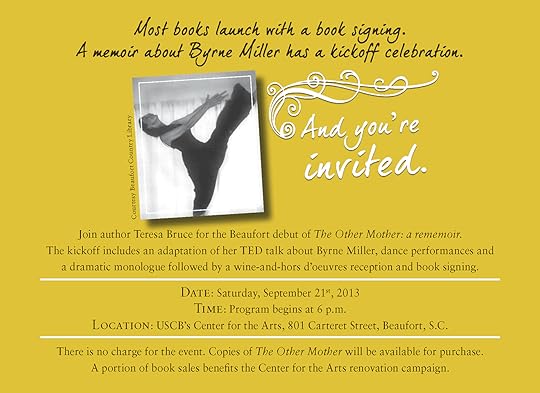 So here goes. It takes more than the author to make a book. It takes a great story — burlesque dancer choreographs a life with unrequited novelist and teaches a young TV reporter the dance of truth, becoming her “Other Mother.” It also takes a partner — and for almost five years my husband Gary has been cheering me on.
So here goes. It takes more than the author to make a book. It takes a great story — burlesque dancer choreographs a life with unrequited novelist and teaches a young TV reporter the dance of truth, becoming her “Other Mother.” It also takes a partner — and for almost five years my husband Gary has been cheering me on.
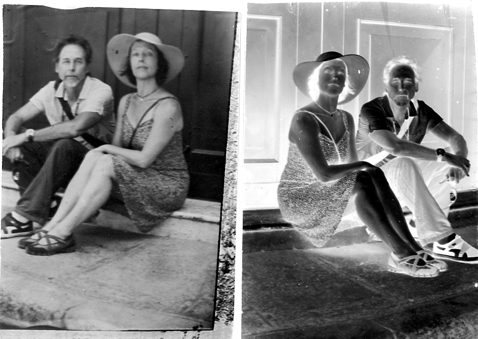
He knows this story, inside and out
But “The Other Mother: a rememoir” wouldn’t have happened without — okay here comes the baby analogy — without midwifery of my publisher and editor: Susan Kammeraad-Campbell of Joggling Board Press. She took the manuscript of a former journalist and helped me deconstruct it. The story started fifty years before I was even born and I was trying to tell it chronologically, through stories Byrne told me over glasses of wine on her screened porch. It felt distant and restrained — nothing like the story that emerged after she showed me how to polish and string together the pearls.

Susan didn’t care that Byrne wasn’t famous. She saw the deeper story.
And so began four years of research, writing and rewriting — interrupted by documentaries and video work to pay the bills. The former journalist in me loved the deep dive into Byrne and Duncan’s past. Even things I hadn’t thought important, turned out to be pivotal.
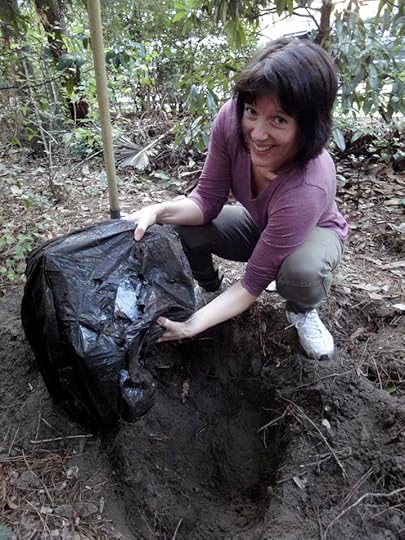
Duncan’s unpublished manuscripts, after I finally figured out where I had buried them. In my own yard.
[image error]
I couldn’t have verified the “pearls” of Byrne’s story without the Special Collections at the Beaufort County Library

I interviewed every sister-and-brother-by-Byrne I could, to corroborate the story. This is my Navajo brother Ben – one of Byrne’s first collected children.
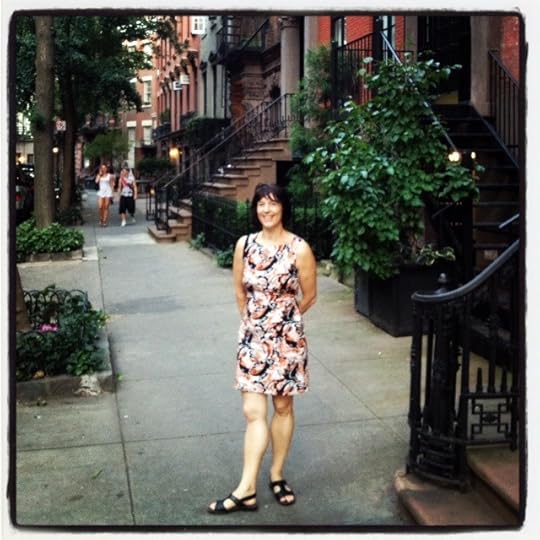
Me, outside the apartment in Greenwich Village where Byrne first lived with Duncan, fresh off her stint as a burlesque dancer on Vaudeville

At Lincoln Center, I watched films of Byrne’s most celebrated teacher: the modern dance pioneer Harald Kreutzberg

I tracked down the exact spot where Byrne’s first work of choreography was born – St. John’s College in Santa Fe
[image error]
Here she is, leading Ben Barney and other young dancers in “The Walls Between” — fifty years ago.
[image error]
I knew I had a story that connected with people when the crowd at TEDx in Charleston gave Byrne’s “womenisms” thunderous applause.
Eventually the research phase was finished and Susan and I began the process of editing each pearl — chapter by chapter. Coming up with
a title was the hardest part… we called it everything from “Dancing with Byrne” to “The Adagio” before settling on the phrase that defined
her. Once we had that, the marketing phase began. I gave a TED talk and created business cards featuring Byrne’s sassiest womenisms.
Byrne would have loved the design process — Torborg Davern did the spectacular cover and Shanna McGarry made the interior just as beautiful. Will Green got the social media ball rolling, making me Tumble, Tweet, Pin and Blog while the advance review copies went out to media, literary competitions and bookstores. So far the reviews are amazing — from Lowcountry Weekly and the Beaufort Gazette.

Will, Susan and interns Jess, Izzy, Lizzy and Maddy all weighing in on changes we wanted to make to the advance review copy.
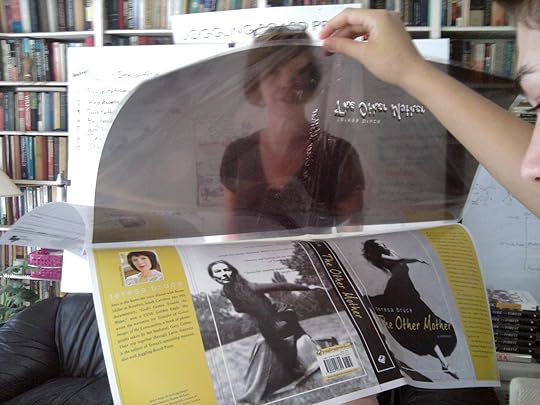
Proofs of the book jacket – I love the happy Byrne on the front and fierce Byrne on the back.

I wrote a whole blog about the fashion of book covers.
While the books were being printed — in Minnesota, USA thank you very much — we got to work planning the launch. Byrne taught
me well. Everything can be a party — from combing through mailing lists to figure out who died, remarried or moved, to
addressing envelopes. Byrne’s “collection” of children is still growing — even in her absence — because of this book. I’m sure
she’s leaping through the air somewhere at the thought of it.

My sisters-by-Byrne, original and new, getting the word out.

Lisa, Lolita and Larry — making sure I don’t forget anyone
Yesterday, the books finally arrived from the printer. Six pallets worth. All of which had to be muscled from the end of Susan’s driveway to her warehouse — good thing for girl power. But at the end of the day I got to hold, in my hands, my baby. I just wish its Other Mother could have been there too, directing the new arrival.

I have trouble imaging the publisher of a NY house doubling as manual labor. That’s me with the hat, doing the author’s part as well

She’s perfect! (of course, the baby’s a she) All embossed letters intact and touchable 


September 10, 2013
The Power of Photography
When you grow up in Oregon, as I did, the Civil War is just another date to memorize for history tests. I was functionally illiterate in “The War Between The States” when I moved to South Carolina in 1989 – stunned at the degree of relevance it still seemed to have in my adopted home town. This was before Ken Burn’s series on PBS and all I knew of the war I knew through photographs. The faded, sepia-toned images of Matthew Brady and Alexander Gardner fixed my understanding of it as a distant madness.
Civil War Era Photography is the subject of a talk tonight at the Beaufort County Library’s Special Collections room – a place near and dear to my memoirist heart. Dr. Robert Lisle will explain the tools some 300 male photographers used to create the images that captured that distant madness. It’s part of the library’s month-long commemoration of the Civil War Sesquicentennial called “One County Reads The Civil War.” Lots of libraries use history to lure in readers – but no other library has a Grace Cordial leading the charge. I counted nearly 40 programs, lectures, readings, showings and tours listed in the library’s brochure – and that’s only the adult section of events.
I plan on going to several, starting with the photography talk tonight. Images capture history in a way that never feels archaic or wordy. The power of photographs to change public perception of war is undeniable – who can forget images like this?
But for me, the photographs of one photographer in particular, go deeper than documentation. They explain why the war mattered. In my PBS documentary “God’s Gonna Trouble the Water,” I used the archival photographs of Henry P. Moore extensively. He traveled to visit the Third New Hampshire Regiment camped in South Carolina in 1862 and 1863. But when the day’s work of documenting soldiers was done, he turned to the plantations of St. Helena, Beaufort and Edisto Island.
I’d seen the shocking photos of the backs of slaves, criss-crossed with the slashings of whips. What Moore’s photographs showed me was the Gullah strength of character, the grinding everydayness of survival, the power of faith and promises when there is nothing else. In the end, photography isn’t about tools and equipment – it is about having something to say.


September 4, 2013
Banana Pudding Angels
As shoots go, I didn’t start out thrilled about this one. It required a ten-hour drive to a town in Mississippi I’d never heard of. A town so small we had to stay in a hotel 40 minutes away. And to top it off, we were filming a nursing home.
Even knowing, as I did, that this was a 5-star rated nursing home that was being featured in a video for a national nursing home convention didn’t comfort me because one of my grandmothers is in a nursing home. Going to visit her is something I feel guilty about for not doing often enough and miserably sad every time that I do. It smells bad. People are parked in wheelchairs in front of blaring big screen TV’s for hours on end. My grandmother told me, every time, how much she hates it. Until she couldn’t remember who I am and stopped talking altogether.
So I wasn’t looking forward to filming a nursing home. From the outside, the one in Waynesboro Mississippi looks unremarkable – a 40 years old, one-story brick building with access code key pads on every door so nobody wanders in or out.
Inside though, was a completely different story. I’m used to places sprucing up when a film crew shows up. You can tell when everyone’s been told to be on best behavior and sense that once you wrap the shoot the carriage will turn back into a pumpkin. Don’t get me wrong. The Pine View staff was excited, but only to show off their Southern hospitality. A 70-year-old nurse named Doris baked us a coconut pound cake. The kitchen staff made sure we got watermelon and fried chicken for lunch. And before we left we had to put a dent in this 15-pound homemade banana pudding.
Nobody here needed to fake anything just because they were being filmed. I’ve never seen employees so proud of where they work and what they do. Working in a nursing home is a tough job – lifting people in and out of wheelchairs, taking them to the bathroom, giving baths, spoon feeding. And this facility wasn’t one of the new, fancy assisted living facilities where rich baby boomers send their aging parents. It’s mostly Medicaid and mostly dementia. The way the staff won top rating was the old-fashioned way – by caring.
The director and the chief of nursing carpool 60 miles each way, every day, to work here. Pine View has a full-time person who calls the families of every resident every day. Just to fill them in on what went right. What their loved one ate that day. Any little thing the nurses mentioned.
We started off filming the department heads around a table discussing how to lower re-hospitalization rates and keep staff turnover at zero. As in nobody quitting in over a year. Then each department head met with their staff in team talks, throughout the day, so that every new hire and janitor knew what the goals were and any problems that need fixing. I usually film videos for Fortune 500 companies and have never seen that kind of internal communication.
I got to be behind the scenes, incognito. I wasn’t directing this shoot or interviewing the head honchos. I was just helping the producer and Gary – I was the film crew equivalent of the housekeepers at the nursing home. So those housekeepers, and maintenance guys, and receptionists talked to me, unguarded, throughout the day.
Here’s the casual conversation that stunned me. I saw an old lady in a wheelchair sitting in the hallway next to a man I assumed was her husband. She patted his knee and asked him if he was going to take her home. He turned to her and said, “Who are you?”
It was a laugh/cry moment – the epitome of dementia. I asked a certified nursing assistant standing next to me how common wanting to be anywhere but a nursing home is. She said it’s normal and lasts a few months. I’ve been on the family side of this — my grandmother pleading to be taken home — but never thought about its impact on caregivers. So I asked the CNA if it was depressing. She said all she can do is be honest. She tells the confused residents that this is their home now and they’re here because their family loves them and wants to make sure they’re safe and healthy. And then she holds their hands and softly brushes their hair until she sees a smile.
My sister in law Lyn, who wrote the book on Person-Centered Care — literally – says this is a kind of revolution. For decades, low-paid caregivers were taught that “therapeutic lying” was the best way to ease that transition from independence to nursing home life. I thought of all the times it was easier not to answer my grandmother’s pleading questions (a form of lying) and imagined how hard it would be to work at a nursing home and have to answer those questions from almost every resident. I wouldn’t cut it at Pine View – that’s how high their standards are.
I still think one day we, as a society, are going to look back and question why we allocated more resources to jails and military bases than state-of-the-art facilities for our elders to age in. But until then, at least there are associations who reward those nursing homes that make the most of what they have: people who care more than most of us can imagine. Banana Pudding Angels.


August 28, 2013
My Naked Truth
In less than a month, my deepest darkest secrets will be revealed at the launch of my memoir “The Other Mother” – well almost all of them. I couldn’t find a way, or maybe didn’t have the guts, to fit in my most embarrassing secret. Jimmy Carter, back when he was president, saw me naked.
Now I’m not saying I was the instigator of his famous admission “ I had lust in my heart.” I was only eleven. And he probably only saw my skinny naked arms clutching my flat bare chest, as I stood hip deep in a glacial lake in Montana. But when you’re eleven, and the President, First Lady and daughter Amy, ride up on horseback to the spot where you’re skinny dipping – the event takes on monumental implications. I cried for days. And just when I was convinced he had forgotten it, my grandmother got flown to DC to interview for a cabinet position. She might have been his secretary of labor if Ronald Reagan hadn’t gotten in the way. She brought back an official photo, and told him the whole story while he signed it. It took about thirty years to forgive her, which I did when I finally visited Plains, Georgia.
President Carter has always been my grandmother Nellie’s personal hero, so it was about time that I really tried to understand why. Besides the seeing-me-naked problem I had with Carter, I was also a rhythmic gymnast on the cusp of the Olympics when he decided to boycott the games. Afghanistan didn’t come close to seeming like a good reason at the time.
But as I stood in the living room of his boyhood farm, it made perfect sense. There is a 1930’s era radio cabinet right under the farmhouse living room window that looks out over a grove of pecan trees. Jimmy Carter’s voice narrates a long-ago event. It was the second heavyweight boxing match between Joe Louis and Max Schmeling. Young Jimmy sat, on a braided oval carpet, listening to the play-by-play of a black man beating a white man in less than one round. His father, realizing the significance of the fight, opened that big picture window so that all the blacks gathered in the orchard could hear the fight without having to ask.
Much has been written of Carter’s faith and the role it played in his presidency and his life as a champion of human rights ever since. But I think the story of the Louis v. Schmeling fight explains how a boy raised on a peanut farm, in the middle of nowhere Georgia, in a time darkened by the most malignant racial attitudes since slavery, developed the principals that defined his presidency.
Obama and Clinton have everyman stories too. But walking into the high school where Jimmy met Rosalyn, preserved down to its inkwell desks and echoing gymnasium, connected me to an America when the best was still to come. There’s an element of nostalgia, to be sure, but also a pragmatism and sincerity that made me realize why my grandmother wanted to work for Carter. Why she still reveres him. If I could pass a bill to bring some of that back to Washington, I’d sign it with a flourish.


August 19, 2013
Romancing the Oyster
Having coffee on the porch this morning reminded me of why visitors spend hundreds of dollars a night to wrap themselves in the beauty of Beaufort county’s creeks, marshes and beaches. First there was the rainbow, arching over the Beaufort River during a sun shower. Then an osprey flew past with a fish clutched in its talons, torpedo style. So forgive me if I’m feeling a little romantic about this little slice of paradise.
I’m blaming it on an aphrodisiac that literally surrounds us – the oyster. Friday I had the chance to help some DNR scientists build castles for these sexy creatures. Yes, you read that right. Not just a home for oysters, or a habitat, but castles. And where better than one of the most scenic spots in all of Beaufort: the marsh abutting the Pigeon Point public boat landing.
It turns out the wave energy at that particular bend of the Beaufort River, and the substrate under the water, demands the VIP treatment. I’ve done other oyster habitat builds for SCORE and Friends of Hunting Island, where volunteers form a human chain and deposit bags of discarded oyster shells into shallow areas to refurbish depleted oyster beds or build new ones. But that works best in muddy, somewhat protected areas. The spot at Pigeon Point needs something heavier, less likely to roll and break apart in the wakes of passing snowbirds.
So the scientists at the Department of Natural Resources and the National Estuarine Research Reserve waived their magic wand and came up with the idea of building castles for oysters in the ACE basin. Here’s a picture of a jon boat full of them. Think cinder blocks but with fancy crenellated tops that stack together like Lego.
Castle building is not for the lily-livered. Only die-hard, hopeless oyster romantics can heft the heavy castles from trailer to jon boat and finally to pluff-mud and sandy river shore.
The skies parted, the humidity lifted and a light breeze seemed to bless the quest. Only one in 1.145 million oyster “spat” (pea-sized, cross fertilized larva — according to Naturalist Todd Ballantine) survive the starfish, oystercatchers and drum fish that prey on them. But one adult oyster can live ten years and yield billions of babies. And if that doesn’t warrant a palatial nursery I don’t know what does.
This is a long-term love story. There are plenty of ways to help keep it going strong. If you missed Friday’s build at the Pigeon Point Landing there are two more chances this week: at 1pm Tuesday and again at 2pm on Wednesday — both at Pigeon Point Landing. The DNR provides oyster-castle-building gloves and plenty of cold water – all you have to bring are your own rose-colored glasses.
If it’s candles and wine you want, then come hear an ACE basin expert – Dean Harrigal – give a GreenDrinks talk at Saltus on Bay Street tomorrow night (Tuesday) at 6pm and stay for a romantic dinner.



